#Like Nintendo was absolutely losing the home console war during that time but they were winning the handheld game like nobody's business
Explore tagged Tumblr posts
Text
Man the 3DS Era was so fun, I miss it.
#Stupid shit#That was the time I actually got into gaming and had my own money so I could actually own a legal console.#And like the community was thriving!!! There was such a strong sense of community!!!#Forum subtitles with their 3DS friendcodes listed aaaaaa#The last console with cell charm holders built into them (I literally had to drill holes into my New 2DS to get it to hold charms)#SO MANY YEARS OF GREAT GAMES#Like Nintendo was absolutely losing the home console war during that time but they were winning the handheld game like nobody's business#Social media was just finally getting it's footing and Nintendo content creators were a thing#And they were sharing leaks and breaking news it was so fun!!!#And yeah that last bit is still around#But a lot of the OGs have succumbed to burnout and it's just not as exciting as it was when it was new#Now when Nintendo news breaks it's like. Who are they suing this time#Iwata dying was absolutely a blow to the company but Reggie leaving was the final nail in the coffin tbh#At least it looks like we're on the up and up now#ANYWAYS I just bought my nephew a 2DS because he was never exposed to that era of gaming so I wanted to introduce him#I'm setting it up now - funn!!!!!!
2 notes
·
View notes
Text
Growing up, parenting and gaming - Longread on life, computer games and finding yourself
This longread is dedicated to and written for all those current and former kids, who had or have troubles growing up, taking decisions, finding themselves in the world they live in, who play games independently of age and – perhaps – have not lost their love for a good game, good times and good buddies.
Perhaps it will help someone in their life. If that happens – I shall think of this writing as useful and my time writing it as not completely wasted.
The ideas have been on my mind for over 2 years now (they started getting very clear when I started doing therapy) and I have to put them on paper now.
Here it goes.
I grew up in the 90s in Eastern Europe. After the USSR collapsed millions of people found themselves without work, perspectives and means of existence. We were lucky that my dad had a good job that was paid in hard currency, however he was barely home – and by that I mean like seeing him 2 or 3 times a month.
We had good living conditions compared to others and my mom did the best she could too take care of my younger bro and me.
The first time we were exposed to computer games was when I was like 7 and my bro was 5 – in the office where the boyfriend of our aunt has been working. We played Dangerous Dave, Scorched Earth, Socoban, Digger, Civilization, The Incredible Machine and some others I do not recall the names. And of course, we liked it and it did not take long for our dad to install them on his PC at home. 2 years later my best buddy got Doom 2 installed on his PC and that was the absolute blast. We spent weeks trying to figure out how to get through level 2 and it was a big holiday when our buddy finally did.
My dad tried to restrict TV and computer time per week, so we always opted for the PC. Over time I learned to turn it on by myself and play when there was no one at home. My dad did not know.
A couple of our friends had 8bit consoles - soviet bootlegs of Super Nintendoes, with TMNT and Chip n Dale, but that was probably it. After all, we were living in a small village with not that many possibilities to make money.
When I was 10 we moved to a bigger city into a 1 room apartment. All 4 of us. This was 1996. 2 other very important things:
We started going to a far bigger school than before, where the mood was totally different from what we were used to. We were bullied and beaten, could not get along with other pupils and teachers and no one actually cared.
Father was home every day.
We started going to a far bigger school than before, where the mood was totally different from what we were used to. We were bullied and beaten, could not get along with other pupils and teachers and no one actually cared.
Father was home every day.
I mean, father was present home every day. It is not like he spent time with us doing sports or whatever. He just had any idea what to do with us as this was his first long time exposure to kids in the 11 years we were a family.
He was more of an authoritarian guy – we were not supposed to waste time in gaming clubs, listen to stupid music (Prodigy, Beastie Boys), we should have studied well, read books, have been doing sports and in general act like good kids.
We were doing some martial arts sports cause mom brought us there. We were taking music classes cause “everyone has to”. We were supposed to help out at home. We were not supposed to hang out with “bad” kid or stay outside till late hours. We were not supposed to smoke, swear and simulate illness to miss classes. We were not supposed to get into trouble.
It is not like we were putting a lot of thought into it. We just moved to the city from rural area and frankly speaking were absolutely not happy about. I guess we just went with the flow.
This was also the time when the first “gaming spot” in town opened – they had 2 Sega Mega Drives II and 1 Sony PlayStation. MK3, MK3 Ultimate, Contra Hard Cops, Golden Axe, some samurai fighting games for the Sega. SPS – Red Alert, Twisted Metal, Duke Nukem, Doom and of course – an incredible breakthrough for its time – Quake 2. And that was a revelation. I recall mom giving us money from time to time. To go play. Sega cost like 1 buck and hour, SPS – 1,5 bucks – far more expensive, so we played mainly on Sega.
At the same time we did have some games at home – Doom, Power Formula 1, Lines, the same Civilization, Lion King, Alladin, Indiana Jones and the Fate of Atlantis, Gods and Dune 2000. Dad did not want to allow us play games. Like, at all. Don’t ask me why he never deleted the games. The PC was mainly used for him to work. So when he left home, he took the power cable of the monitor and closed it in his spare suitcase. What we did was to unplug the cable from the printer and use for the monitor. Later on he hid both cables – from the monitor and the PC in the suitcase. I found a way to open the suitcase with a very fine flat screwdriver. Mom hid the fact from our dad for a while until he noticed the suitcase was “broken”. I believe they did not speak with each other for a week. But I am still proud of the fact of cracking that suitcase! Fuck yeah!
Things started getting worse when I transferred to a lyceum - 1998. I was 12. This was like a gymnasium for hardcore science-kids, where they went deep into math and natural sciences. I was hysterical the first 2 years as I was barely making the program. Even my dad had troubles solving the math they gave us. Music classes turned to shits. I had no time nor mood for sport. But I had to keep doing it all. Just because. There were a couple of bullies in class, whose parents bribed the management of the school so that their kids would have fancy graduation papers at the end and frankly speaking no one could get a grip on them. That had me very depressed.
Around 13 I started stealing money from my parents and missing classes to go to computer clubs – their number was getting bigger every week, consoles started to disappear. Half Life, CS 1.6, Age of Empires 2, Q3, D2 1.07, Black and White, SimCity 2000, NOX, StarCraft Brood War and many other games had our full attention. The biggest part of it was the fact you could play with or against your friends! That was so fucking awesome! At the same time I started discovering sci-fi and rock music, but that is a different story.
We stole a lot of money from our parents in those times and missed a lot of classes and of course after 3 or 4 months it all got revealed. Boy oh boy our dad smoked us. That was very very tough for a kid when all the things he actually liked were taken from him. Dark times when we were seriously asking ourselves what the hell our parents wanted from us as aside from the stuff they told us to do they never really told us what was it for. Everything else was useless, stupid or waste of time.
Somehow my marks at school got better closer to graduation and I graduated almost with a medal, went to university. I remember they had this PC club with like 200 PCs and from time to time we skipped one or the other lecture to play Starcraft or CS, but very quickly boozing with buddies became the major leisure activity and pushed gaming to the back. I did pretty well at the university, made my master with excellence and that was it – 6 years flew by in a blink of an eye.
I got my own PC during the first year at the uni, played a bit of Warcraft 3, HOMM 3, Quake 3, Lineage II but it was not like I was deep into that. I remember after defending my master I spent like 3 days playing Crysis without anyone saying a word. I mean, I was through with the university. I was free!
Soon after that I went on to work abroad as a project engineer in the chemical industry.
At the moment I am doing sales engineer for a good salary in Berlin, I am married and except for the Corona and all the restrictions it brought life seems ok.
During the last 10 years of my “adult” life I have been in many different situations. I have been very sick a couple of times, running on the edge of life and death. I have been in some useless relations that only drained energy and nerves from me. I also have been diagnosed with depression and burnout at some point, did therapy and consider myself fully recovered from both. I’ll be summarizing it all below.
When I look at my life it did occur to me that gaming was far more important than just the sheer desire to shoot buddies and skip school.
Growing up under the conditions where everything is predetermined one does not really get the chance to expose your own wish. After all, my parents both come from very unhappy families and did not have the exactly best examples of parenting.
It occurred to me that they never really cared about anything we achieved – whether in school, music or sports. I recall a couple of times when I did really good, like winning the City-contest in English language or getting my first “good” in algebra in 7th grade as that shit was extremely tough. I do not recall any reaction. In fact, mom and dad put their close attention to us only when things started getting really bad, like when we were skipping classes or got arrested for setting up fireworks in a crowded place. We never really got any positive feedback for anything we did because our parents just had no idea how to do that. I do not blame them – they were trying their best from their own experience.
And gaming was the absolute opposite to all of that.
Going to computer clubs we knew exactly that we were surrounded by like-minded lads. We made some good friends along the way – lads, who were always ready to jam on de_dust or bring their D2 chars to share some loot. One of the owners of the club had a daughter who was really good in Q3 – I remember everyone has been looking at her like she was some sort of demigod. The games gave us the space and playground we needed so much – clear even rules for everyone. If you frag – you win. If you don’t – you lose. If you suck – the older guys would always help with a couple of tips. Games also gave us control. I really liked the games where you went on an adventure, like NOX or Will Rock or serious Sam. Gaming also gave us the space to take our own decisions and suffer the full consequences if these were wrong – getting overrun by zerglings or getting fragged with rocket launcher with QUAD DAMAGE.
Gaming clubs were our safe space. At some point our dad did raid the computer clubs and did bust us a couple of times. Sure we got beaten on those occasions.
I recall my bro being very proud on getting 1st in the national 2v2 ladder in SC:BW later in the uni. He also used to game the whole night long at my parents place. This was over 10 years ago and they still do not know. He is still very good in SC though he does not play anymore.
I do play sometimes – currently grinding D2 and refreshing my knowledge in chess. I do not have more time for any other more or less serious game.
I am slowly approaching the point where I should write a conclusion – it is going to be quite simple. Gaming was the first opportunity to take my life into my own hands. It took me 32 years of my own life to find the power in me to take responsibility for myself and not to rely on someone else. My decision – my choice – my consequences. It took a lot of trouble and turmoil for me to get to this point and finally embracing the power within feels great. It was also the first surrounding of dudes just like me, which was a very good feeling back then.
During the last 6 months I switched to a job that pays almost the double of my previous one, my wife moved in with me from abroad, we have a nice apartment and are looking forward to vacations in the Alps. I still have to find a way to approach my parents though I am not sure the old hive is worth disturbing. I guess time will tell.
Whenever I am down or things do no go according to play – I do turn to gaming occasionally, just to get back into the world where I am in full control. It gives me power and I guess hope that everything will work out. If not now – then over time. You just have to keep practicing. And ask for help when it is needed.
I hope you found this read interesting.
1 note
·
View note
Photo

The best PS1 games of all time: From Symphony of the Night to Final Fantasy 7 http://bit.ly/2WiC9N8
Sony tentatively entered the video game market by partnering with Nintendo to develop a new, disc-based console in the mid-90s. After that partnership fell apart, Sony went on to release a console of its own.
The first PlayStation launched in Japan in late 1994, and in the following year, to the rest of the world. Although the PS1 wasn’t the first console to use CD-ROMs or provide true 3D graphics, it created the breakout moment for both of those technologies in gaming.
Ranging from novel-length, narrative-driven RPGs to fast and furious races to mind-bending puzzles, games for the original PlayStation offered a wildly diverse lineup over its 11-year production run.
Take a stroll down memory lane with us as we count down the 50 best PlayStation 1 games ever made. Do they hold a candle to the best PS4 games? You decide.
Action
Castlevania: Symphony of the Night

The Castlevania series was over a decade old by the time Symphony of the Night arrived, but it was absolutely the franchise’s defining moment. It radically expanded the series’ platforming with RPG loot and progression and non-linear exploration, lending its suffix to the subsequent “Metroidvania” genre as a result.
Unlike previous Castlevanias, where you controlled members of the vampire-hunting Belmont family, SotN revolves around Alucard, the lazily-named son of Dracula, who fights the horrible monsters of the castle to protect humanity from his father. Symphony of the Night stood out immediately for bold choices like hiding more than half of the game behind a false ending, or using the CD format to make a massive game filled with rich, 2D sprites instead of the crude, early 3D the rest of the industry was pursuing at the time.
One of the most influential action-RPGs of all time, Castlevania: Symphony of the Night is still just as satisfying to play now as it was 20 years ago.
Metal Gear Solid

Between Thief: The Dark Project on PC and Metal Gear Solid on PlayStation, 1998 was the year that modern stealth video games were born. A sequel to two lesser-known games from creator Hideo Kojima, you play as special ops soldier Solid Snake, infiltrating the hideout of a rogue unit threatening the United States with a nuclear strike.
Snake has a variety of tools for evading and taking out guards, making it one of the most taut and tactical gaming experiences available at the time. The series has since spawned four more critically-acclaimed main entries and various spinoffs, radically expanding upon both its deep gameplay and Kojima’s baroque, nuclear mythology. But the first Metal Gear Solid remains an unassailable classic.
Twisted Metal 2
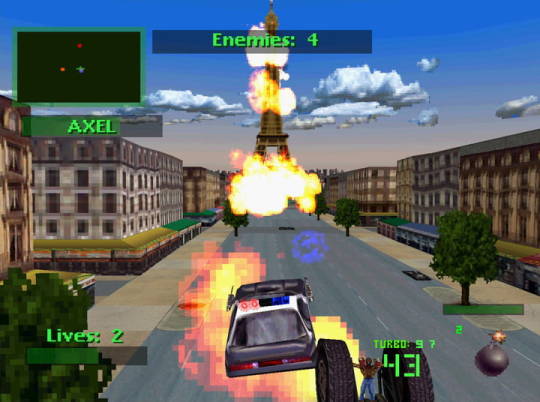
Prior to leading the team behind God of War, designer David Jaffe rose to prominence for his work on the PS1 vehicular combat series, Twisted Metal. In the demolition derby taken to a post-apocalyptic extreme, players take the wheel of various over-the-top armed and armored vehicles. Projectile weapons and power-ups are scattered throughout the arenas, set in the ruins of major cities around the world. The cars and drivers — like the series’ iconic ice cream truck, Sweet Tooth, and Axel, a muscle-bound man straddling two truck tires — ooze personality even in the early polygonal days of 3D.
The first game included only a single-player campaign and co-op mode, but the sequel expanded everything about it, including more vehicles, more arenas, and more custom and multiplayer modes for just dropping in and enjoying the mayhem à la carte. A contractual dispute between Sony and developer SingleTrac led to subsequent sequels being developed by other, less capable studios, making TM2 the peak of Twisted Metal for most fans.
Legacy of Kain: Soul Reaver

An action-focused spinoff of the top-down RPG series Legacy of Kain, Soul Reaver was a third-person action game from Crystal Dynamics, which would go on to earn acclaim with its reboot of Tomb Raider. You play as the ghostly vampire Raziel in the grimdark fantasy world of Nosgoth.
Players loved its dark, compelling narrative, voice acting, and varied mechanics. One of its main conceits was the ability to swap between the physical and spectral realm at any time. Crystal Dynamics was unable to simply layer two different versions of the world on top of one another because of the console’s limitations; achieving the effect was no small technical feat.
Legacy of Kain: Soul Reaver is also notable as one of the first major games written by Uncharted series scribe Amy Hennig, now considered among the best game narrative creators in the business.
Tenchu: The Stealth Assassins

With their long-held mystique both within and beyond Japan, ninjas have featured prominently in video games since very early on. In franchises like Ninja Gaiden, however, they had largely been translated into nimble, hack-and-slash fighters. Tenchu: The Stealth Assassins is one of the first games to truly embrace the ninja as a stealthy infiltrator who must rely on his tools and wits to survive, rather than just weapons and reflexes. Developed by Japanese studio Acquire, Tenchu was the feudal Japanese parallel to Metal Gear Solid’s nuclear melodrama. Failing a mission would cause you to lose whatever tools they were carrying at the time, forcing you to be careful and deliberate when planning your approach to each mission. Fantastical elements from Japanese mythology provided fun flavor, but Tenchu was most fun because of how human and vulnerable you felt, making success all the sweeter.
Syphon Filter

Although somewhat overshadowed by Metal Gear Solid, Syphon Filter was another exceptional 3D, third-person action-stealth game for the platform that was praised at the time even if its legacy has not endured as strongly. Newbie developer Eidetic took equal inspiration from Goldeneye 007 on the Nintendo 64, hoping to create a “super-spy” hybrid genre with stealth, action, and puzzles.
It tells a gritty, contemporary story about special operatives facing off against biological terrorists in a world-spanning story that encompasses governments, multinational pharmaceutical companies, and conspiracies that run all the way up to the top. It was a pulpy and immersive plot, enhanced greatly by gameplay that was a compelling balance of stealth and straight-up action. Critics cued into its stellar AI, a key requirement for good stealth games, which was among the most impressive in any game to date.
Einhänder

Although best known at the time for its roleplaying games, Japanese developer Square was no one-trick pony. Case in point: It also gave us Einhänder, an absolutely fantastic side-scrolling shoot-’em-up in the tradition of Gradius (though not quite as extreme as the “bullet hell” subgenre that came after it).
Set in the future during a war between Earth and the Moon, you pilot a spacecraft through horizontal, 2.5D levels, destroying enemies and collecting power-ups. The name, a German word for a one-handed sword, alludes to the core mechanic of your ship’s sole grappling arm, used to pick up weapons scavenged from destroyed enemies. Weapons mostly have finite ammo, forcing the player to keep finding new ones and adapting their play style to what’s available.
Apart from the generally slick presentation, players loved the tactical variety enabled by the system of picking up new weapons, as well as the way that bosses had discrete parts that could be targeted and disabled. Although well outside of Square’s wheelhouse, many consider Einhänder to be one of the genre’s best, and Square’s finest non-RPG work to date.
Ace Combat 2

The original Ace Combat (released as Air Combat) was one of the first games released on the original PlayStation, and it showed. This sequel was an improvement by developer Namco in basically every way. Gameplay is divided into relatively linear, objective-based missions, with resources becoming available to upgrade your jets depending on how successful you were at destroying all targets.
It’s an arcade-style combat flight simulator, “arcade style” here referring to its gameplay-over-simulation design, with only semi-realistic physics and the ability to carry far more missiles than an actual jet could — though difficulty settings allowed more hardcore players to fly with greater realism if they so desired.
Mega Man Legends 2

Although the PlayStation hosted some of the best conventional 2D Mega Man games as well, it was also the exclusive home to some weird entries like Mega Man Legends, as well. With only the main character in common (and a cheeky reference to how he’s named after a character’s favorite video game), Legends is set in an archipelago where he travels around with the Caskett family of treasure hunters, scouring ruins for ancient machinery in search of the legendary Mother Lode.
In addition to refining the run and gun mechanics (replete with a fairly deep crafting and customization system), the second game also presented a much richer and more character-driven narrative than the structure typical to the core series of “hunt the bosses to get their powers.” The voice-acted cutscenes were particularly entertaining, feeling very much like watching an anime. It featured memorable characters like your nemesis, the pirate Tron Bonne, who had her own spin-off game between two Legends entries. A third game was canceled in development.
Tomb Raider 2

The original Tomb Raider essentially founded the genre of the 3D action/adventure game, but it’s the sequel that really made it sing. A radical departure from the cutesey, cartoon mascots of the previous console generation, international treasure hunter Lara Croft was immediately embraced as one of gaming’s most iconic characters, heralding the medium’s maturation.
The first game’s mix of exploration, platforming, combat, and puzzle-solving was expanded substantially for the sequel, with refined controls, bigger environments, and more exciting set-pieces. The third game felt a bit more like a rushed cash-in, leaving Tomb Raider 2 as the series’ peak for a lot of players until the universally-praised 2013 reboot.
Fighting
Bushido Blade
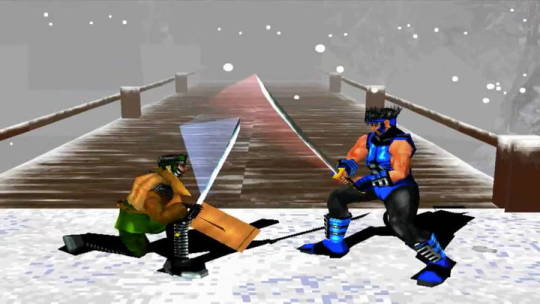
Feudal Japanese weapon-focused 3D fighting game Bushido Blade is the most well-known game from Japanese studio Light Weight, and it’s still somewhat anomalous within the genre. Eschewing the convention of health bars entirely, blows would either cripple particular body parts or kill you outright. This gave the game a rare degree of realism, and a much more tactical and punctuated tempo.
There were eight realistically simulated weapons and six characters with different stats, abilities, and proficiencies with each weapon, and a stance-based fighting system, giving players a lot of options. Also unlike the discrete levels of conventional fighters, its arenas were all inter-connected, and players could run and climb between them, using the environment to their advantage.
Bushido Blade had one direct sequel and another similar title on PS2, but those smoothed out some of its quirks too much for our taste. Other fighting games like the Soulcalibur series and more recently For Honor have explored weapons-focused “dueling,” but nothing has quite replicated what made the original Bushido Blade special.
Tekken 3

Street Fighter set the bar for 2D fighting games in the early 90s, but brawling in the third dimension was all about Tekken. This arcade-native franchise set the high bar for 3D fighters, perfecting the formula with the third entry. Where previous entries made relatively little use of the third dimension, depending on the character, Tekken 3 toned down the hyperbolic jumping and made it so every character could easily sidestep into the third dimension, opening up one of the most tactically complex and polished fighting systems in video games to date. A large and diverse roster of characters and truly impressive graphics for a home console port of an arcade game made Tekken 3 an instant classic, and it still holds the honor of being the second-best selling fighting game on any platform of all time, after only Super Smash Brothers Brawl.
Street Fighter Alpha 3

While Tekken and Bushido Blade blazed new paths for fighting games in the third dimension, Capcom stuck to its roots with Street Fighter, the fighting franchise that started it all. It featured a massive roster of 34 combatants drawn from the series’ whole history. It also introduced three different “isms” playstyles, changing the mechanics of how combos work and special moves charged up. While some felt that the 2D, sprite-based graphics dated the game, in retrospect it looks great, and holds up magnificently well as one of the most comprehensive and refined entries in the Street Fighter franchise.
Darkstalkers 3

Capcom was on such a roll producing top-notch fighting games during the ’90s that it sometimes overshadowed its own excellent titles. The Darkstalkers series of 2D fighters was always a cult and critical darling but had middling commercial success. Relatively standard (but solid) mechanically, it was mostly recognized for its anime-meets-gothic-horror aesthetic, with characters like vampires, mummies, demons, and a yeti. The look was magnificently refined by the time it hit the third game, with detailed and fluidly animated sprites that are among the best of the decade. First released in arcades, the game had undergone several character additions and balance changes by the time it was ported to PlayStation — all of which made it one of the fastest, fun, and charming fighters to play at home.
Platformers
Crash Bandicoot

Recently remastered in full, Naughty Dog’s original Crash Bandicoot trilogy (recently remade for PS4) endures as one of the most iconic 3D platforming series from the genre’s heyday. As the eponymous Crash, you are a mutant bandicoot (an Australian marsupial) on a quest to stop Dr. Neo Cortex from taking over the world with an army of other mutant animals.
The gameplay is standard for the genre — patrolling enemies, jumping challenges, power-ups, and collectibles, though levels were generally linear: It’s more Mario than Banjo-Kazooie. It was most highly praised at the time for its visuals, which felt more like a playable cartoon than any game to date. The vibrant character in Crash’s various death animations were particularly memorable in that regard.
Oddworld: Abe’s Exoddus

The original PlayStation was a fascinating, transitional period in game design, with a big uptick in processing power and storage opening up a whole new field of possible aesthetics to explore. Oddworld: Abe’s Oddysee was a cinematic platformer in the tradition of Prince of Persia or Another World. You play as Abe, an enslaved member of the Mudokon race, leading a rebellion against their corporate overlords before they are turned into a cheap food source.
It’s grim satire for sure, but full of warmth, humor, and loving attention to detail. As Abe explores, solves puzzles, and avoids enemies, he has to rely on his wits more than anything else, because he’s liable to die without much effort. The sequel, Abe’s Exoddus, picked up right after the first game and enhanced it with both quality of life improvements such as quick saving, and more elaborate puzzles based around communicating with NPCs. A recent, well-received remake of the original shows that there’s still a lot to be enjoyed in this classic series.
Rayman

Before designer Michel Ancel gave us Beyond Good & Evil (will the sequel ever appear?), he created one of the most enduring characters in platforming, Rayman. Released early in the PlayStation’s life cycle, Rayman was a stunningly colorful and charming 2D platformer, using the console’s 32-bit processor to present one of the most vibrant and detailed games to date. The story was light, fantastical nonsense, as the eponymous Rayman fought and jumped his way through various themed worlds to defeat bosses and save the day.
Rayman subsequently took a detour into 3D platforming as well, but his real legacy was secured in 2011’s Rayman Origins, which returned to the bright, animated aesthetic of the original. It didn’t rock any boats in terms of gameplay, but Rayman is still beloved as one of its generation’s most solid iterations on the platforming genre, which is still alive and well today.
Spyro 2: Ripto’s Rage

In the immediate wake of the Sonic vs. Mario console wars of the early-to-mid 90s, marketers still held onto the idea that a console needed a family-friendly platforming mascot to succeed. Next to Crash Bandicoot, the cutely-proportioned Spyro the Dragon competed for that spot on the original PlayStation.
En route to vacation, Spyro is pulled through a magical portal into a fantastical world under assault by a warlock who gleefully discovered there were no dragons to bother him. Spyro collects a series of MacGuffins to progress through nonlinear levels and unlock new traversal and combat abilities.
The whole first trilogy, developed by Insomniac Games, is well remembered for its colorful characters and solid platforming, but for our money, the second one hits the sweet spot of refined mechanics and freshness.
Klonoa: Door to Phantomile
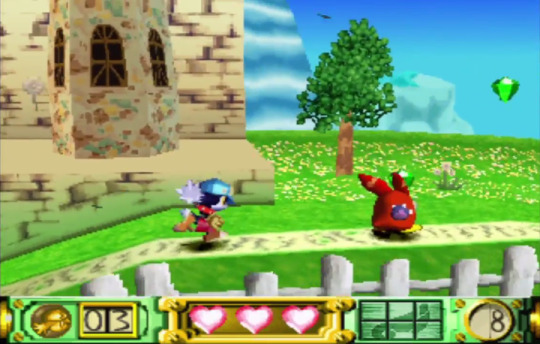
The transition from 2D to 3D gaming produced a lot of interesting artifacts, but oddly enough, most developers didn’t think to try the intermediary style that’s grown more popular in recent years: so-called “2.5D” (action rendered in 3D but largely constrained to a 2D plane). This Namco-developed platformer is set in Phantomile, a fantastical realm manifested from the dreams that people forget soon upon waking.
You play as Klonoa, an anthropomorphic resident of Phantomile with a power-granting wind spirit that inhabits a ring. Gameplay is standard for the genre, with enemies, puzzles, and bosses spread out across themed levels. Praised by critics at its release, Klonoa can be hard to find now, particularly outside of Japan, but is fondly remembered as a solid and enjoyable platformer.
Jumping Flash!

Released in 1995, one year before Super Mario 64, Jumping Flash! holds the honor (according to Guinness) of being the first truly 3D platforming video game. Presented in first-person, you play Robbit, a robotic rabbit, exploring open levels to collect four MacGuffins (“jump packs,” in this case) to progress through its six themed worlds, each with a culminating boss battle after three levels.
Robbit’s ability to triple-jump mid-air is the game’s mechanical focus, supplemented by various power-ups with classic effects like temporary invincibility, extending the level time limit, or increasing Robbit’s health. Although it was soon overshadowed by the flourishing of 3D platforming’s imminent golden age, Jumping Flash! is still an innovative and under-appreciated trailblazer.
Ape Escape

In this third-person platformer you play a boy, Spike, tasked with travelling through time and using a variety of gadgets to capture hyper-intelligent apes that are meddling with history. It was the first game to require the PlayStation’s DualShock controller before the now-standard vibrating two-stick model came stock with the console. Rather than using the right stick to control the camera, it was used to manipulate the gadgets. Acclaimed at the time and fondly remembered since, it’s a seminal moment in platforming video games for both its cutting edge presentation and mechanics.
Puzzle
I.Q.: Intelligent Qube

The PlayStation’s most memorable games tended to be immersive fantasies, yet there were a few exceptions more purely focused on gameplay. I.Q.: Intelligent Qube was a 3D puzzle game in which a player ran around on a gridded platform, clearing cubes before they push him off into the void. It was a challenging brain-tickler, given more replayability with the ability to create new levels, a feature that unlocks after completing the game once. Although released in the West, it was most successful in its native Japan, garnering several sequels.
Super Puzzle Fighter II Turbo
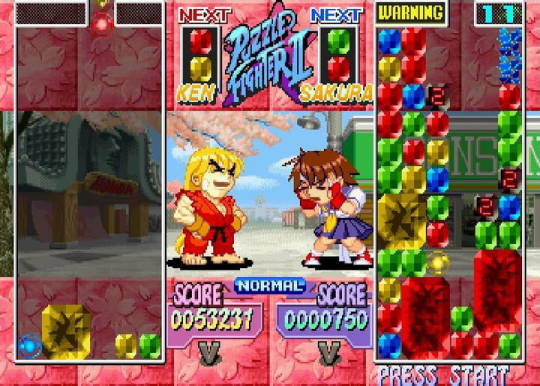
This port of a hit Japanese arcade puzzle game for one or two players isn’t actually a sequel to anything, but is cheekily named after Super Street Fighter II Turbo because it bolts the aesthetic and interface elements of Capcom 2D fighters onto a falling block puzzle. In it, Chibi versions of Street Fighter and Darksiders characters performed a silly battle that reflected what was happening in the puzzles.
Capcom developed the game for Japanese arcades in response to the popularity of Sega’s Puyo Puyo 2. It employed similar competitive mechanics to Puyo of successful chains dumping garbage blocks onto the opponent’s field, which could be countered with a quick combo in response. The charming 2D graphics and solid competitive puzzling mechanics have aged beautifully, maintaining this game’s reputation as a delightful cross-genre curio.
Racing
Gran Turismo 2
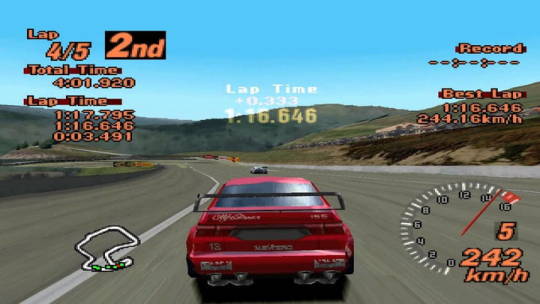
Hyper-realistic driving sims are flourishing, but Gran Turismo was the cream of the crop for virtual gearheads in the PS1 era. The smooth forms and inorganic materials of cars have always been an excellent test case for the cutting edge of realistic graphics, and as such Gran Turismo 2 was one of the first games where you might glance at the screen and think you’re watching live television.
The gameplay, graphics, and physics were largely unchanged from the first game, with the most notable expansion being in Gran Turismo 2’s enormous roster of real-world cars (over 600, the largest in any game to date), a robust customization system, and more flexibility to take part in races à la carte, rather than necessarily structured as tournaments. It was a bestseller among both car fans and regular gamers, establishing Gran Turismo as a key racing franchise that has endured through the present.
Wipeout XL

Like F-Zero on the SNES, the Wipeout series let players experience fantastical levels of speed in futuristic racing. Players piloted extremely fast, anti-gravity ships through dramatic, high-tech courses. Gameplay revolved around extremely high speeds, power-ups, and utilizing air brakes for drifting turns around tight corners.
Expanding and improving upon the first game in nearly every way, Wipeout XL was praised for its intense gameplay and slick presentation, including a techno music soundtrack and detailed background worldbuilding that made it feel like the immersive, futuristic entertainment video games had promised to become since the 80s.
Crash Team Racing

Mario Kart clones flourished on all consoles in the years following the success of Mario Kart 64, and Crash Team Racing was handily the best available on the PlayStation. Developed by Naughty Dog, it featured characters from the Crash Bandicoot trilogy kart racing for up to four players. Like its obvious inspiration, it featured aggressive and speed-boosting power-ups, drift turning, and whimsical, elaborate courses.
Unlike Mario Kart games, in addition to standard, time trial, and battle modes, it also included a story that progressively unlocked additional characters and modes as players completed it. For the most part, it didn’t shake up the formula in any substantial ways, but it was a solidly designed, good looking, and fun game that filled a definite niche for PlayStation owners. Not every great game needs to reinvent the wheel, after all.
R4: Ridge Racer Type 4

Between the simulation-focused realism of Gran Turismo and the wacky hijinks of Kart racers, you have Ridge Racer. R4, the Namco-developed series’ final entry on PlayStation, looks like the former, but plays closer to the latter. That made it perfect for racing fans who wanted the fantasy of realistic-looking cars but were turned off by realistic handling. 321 vehicles to unlock and a variety of tracks and modes make this a great package for anyone who wanted a rich, arcade-style racing experience. Many still consider it the peak of the Ridge Racer series.
Driver: You are the Wheelman
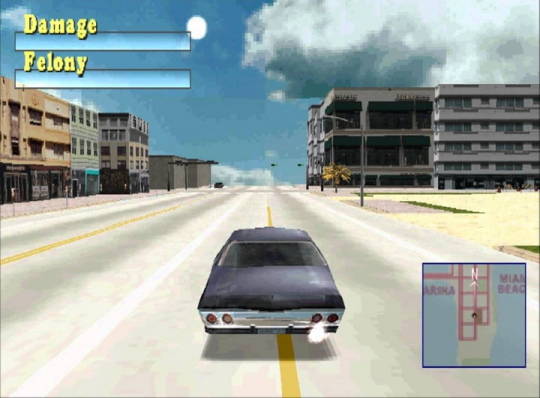
While most driving games framed the action around races, Driver instead sought to recreate the feeling of 60s and 70s car chase movies like Bullitt or 1978’s Driver. Set in open-world urban environments inspired by real cities, Driver looked forward to the sort of hijinks that would come to define Grand Theft Auto games, like escaping from cops or smashing up other cars. It also included an interesting Film Director mode that allowed players to capture replays with particular camera angles.
Rhythm
PaRappa the Rapper
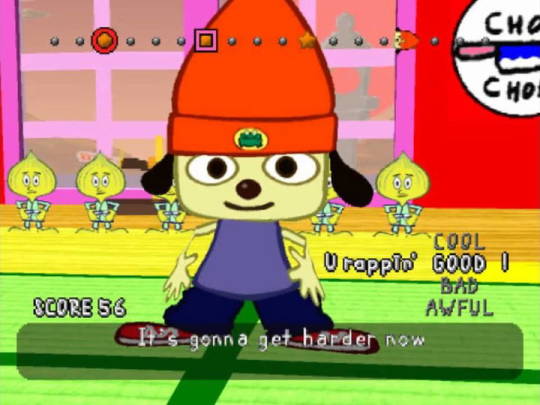
Before Harmonix made the genre blow up with Guitar Hero on the PlayStation 2, PaRappa the Rapper was the name in rhythm games. Sidestepping the crude stabs at realism that contemporary developers were making with the console’s nascent 3D tech, PaRappa features colorful, 2D characters in 3D environments. This highlighted design over horsepower, decades ahead of current trends to integrate 2D and 3D artwork into more visually interesting aesthetics than the brown-grey realism that dominated the early part of the millennium.
PaRappa’s bright and cheery look was a 90s hip-hop Day-Glo fantasia, and the music, while lyrically inane, holds up shockingly well over 20 years later. PaRappa the Rapper has been technically surpassed by subsequent rhythm games in nearly every regard, but it’s still rightly beloved as a groundbreaking curio from a time in gaming before genres became quite so crystallized and anything felt possible.
Vib-Ribbon
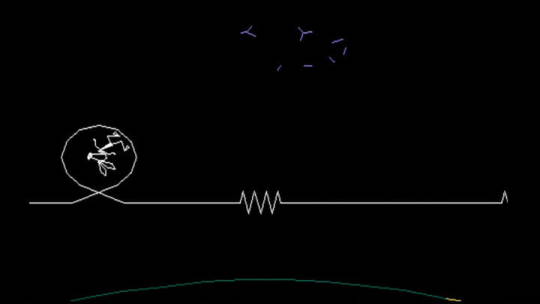
Although Vib-Ribbon is one of the most visually primitive games ever released for the original PlayStation, ironically it could now most easily be mistaken for a contemporary indie title. In this minimalist rhythm platformer, you play Vibri, a rabbit who must traverse courses generated procedurally from the music, all rendered in simple, white, line vector graphics on a black background.
The game’s lightweight visuals meant that it could be loaded entirely into the console’s RAM, and thus players could generate levels based on any music CDs they put in. Using CDs to generate material for games had been explored on PlayStation already in Monster Rancher, but Vib-Ribbon was the first to integrate the content itself into the game. Well ahead of the curve for both rhythm games and minimalist, procedural platformers, Vib-Ribbon feels nearly timeless now.
Role-playing
Final Fantasy IX
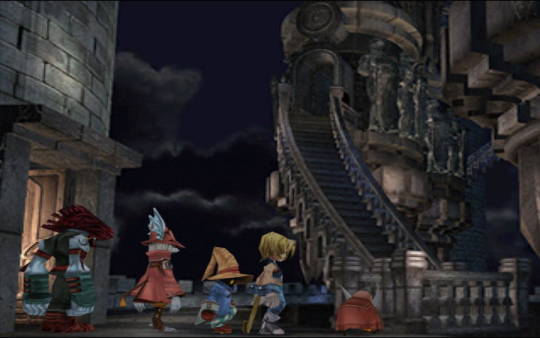
Breaking off from the trajectory of Final Fantasy VII and VIII toward gritty sci-fi, FF9’s return to the stylized, chibi aesthetic and light-hearted fantasy of the series’ original entries left many fans turned off. In retrospect, it stands out as a fantastic synthesis of the franchise’s recent ideas with its classic mechanical and worldbuilding tropes. It follows the rogueish Zidane, the rebellious princess Garnett, and their assembled friends taking on the sinister Queen Brahne and her world domination plans. It’s classic Final Fantasy through and through, and is easily the most charming and fun entry from the era.
Final Fantasy VII

Perhaps the most famous entry of the premier Japanese RPG franchise, FF7 was a massive, breakout event for the series, breaking into the third dimension and reaching far wider audiences than ever before. It tells the tale of mercenary Cloud Strife and his ragtag friends taking on the sinister Shinra Corporation, which is literally draining the planet’s life force. The chunky, polygonal visuals haven’t aged well, but characters like Sephiroth and moments like the death of Aeris loom large for gamers (as evidenced by the hugely hyped remake in the works), making this still one of the most influential and well regarded RPGs of all time.
Chrono Cross

Squaresoft RPG Chrono Trigger is still widely considered one of the greatest video games of all time. Its PlayStation sequel never achieved the same reputation, but it’s nevertheless a fun and interesting game that holds up quite well. Like the first game’s different time periods, Chrono Cross’ primary narrative conceit was jumping back and forth between two parallel timelines, in one of which the protagonist had died as a child.
The game features over 50 recruitable characters, each with their own personal quest to follow, making it literally impossible to see everything in a single playthrough. The connections to the first game are non-obvious at first, but ultimately it ties them all together in an interesting and resonant tale that frequently meditates on loss and regret. It’s also colorful, fun, and features unique approaches to both combat and progression.
Xenogears

Another fiercely loved Squaresoft RPG, Xenogears started as a pitch for Final Fantasy VII, but eventually spun off to start its own science fiction franchise. Long and ambitious, it amazed some and perplexed others with the plot’s complicated political and religious themes, along with a healthy dollop of Jungian psychoanalysis.
You play as the amnesiac young man Fei Fong Wong in a quest to save the world from Deus, an ancient, planet-killing weapon that has gained sentience. Gameplay featured both conventional, Final Fantasy style active time battles, as well as fights in the eponymous Gears (giant mecha suits) that involved managing action points and developing combos. The first Squaresoft RPG to feature voice acting and anime cutscenes, Xenogears was a leap forward in the medium’s potential for mature and cinematic storytelling.
Vagrant Story

Yasumi Matsuno’s action RPG stood out from its peers at Square because of its razor focus. Rather than assembling a ragtag crew of wacky misfits to save the world, you play a single character, Ashley Riot, a knight sent after a cult leader who kidnapped a noble family and absconded to a ruined medieval city, Leá Monde.
Like Parasite Eve, it featured pausable, real-time combat and the ability to target and be targeted on particular body parts, crippling particular capabilities. Combined with an elaborate weapon crafting and armor system, it provided a rich and focused tactical playground that players enjoyed experimenting with for years. It was essentially retconned into Ivalice, the world of Final Fantasy Tactics and XII, but even without that it would stand alone as a beloved classic for its mature story and mechanical depth.
Final Fantasy VIII
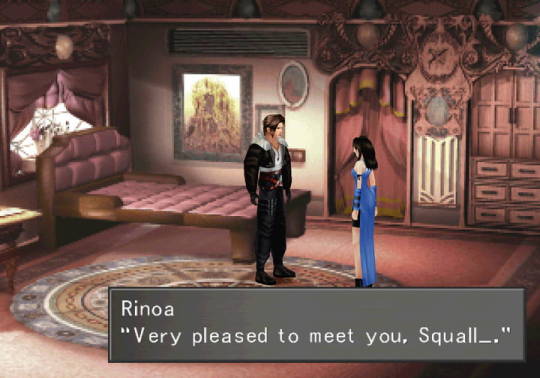
Following the explosive, global success of FFVII was a tall order, but Square managed to keep aggressively evolving the series for its immediate sequel. Final Fantasy VIII was the first in the series to feature realistically proportioned characters and continued the move from 7 towards the fantasy-infused sci-fi aesthetics that defined later entries.
The story revolved around Squall Leonhart and a party of other freshly-trained SeeD mercenaries in a quest that quickly turns from political to world-ending stakes. Fans also latched onto the romance between Squall and fellow party member Rinoa, which featured an original vocal track (a series first), “Eyes on Me” by Chinese singer Faye Wong.
The game was a radical departure mechanically, getting rid of magic points in favor of the elaborate “Junction” system of drawing finite quantities of spells from enemies that you could either cast or hold onto in order to buff up particular stats. It was an odd system that didn’t make it into subsequent entries, but demonstrated the franchise’s ongoing willingness to reinvent itself in core ways.
Suidoken II

While widely beloved by fans and critics, Suidoken II’s limited print run and distribution prevented it from reaching the universal acclaim that Final Fantasy games found on the PlayStation, at least in the West. Loosely based on the plot of a classical Chinese novel, it was most praised for its story: a complex and mature political saga of warring nations and city-states struggling for independence.
The scope of that narrative was reflected in the scope of the party you could recruit, with over 100 characters able to join you through personal side quests (though not all in combat roles). It featured both standard turn-based party battles in the vein of Final Fantasy as well as large-scale, strategic engagements on a grid more reminiscent of Fire Emblem. Suidoken II was about as epic as you could get on the PlayStation.
Legend of Mana
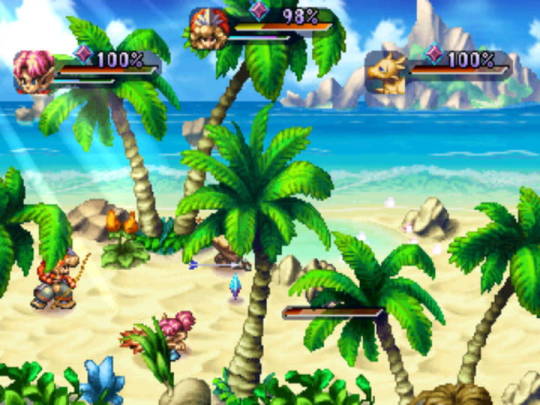
The Secret of Mana series grew up alongside Final Fantasy in the 8- and 16-bit eras (the first game was actually sold in the United States as Final Fantasy Adventure), generally taking a slightly lighter tone and substituting the turn-based battles with more open, action RPG gameplay. Legend of Mana is the fourth entry (following the fantastic Seiken Densestsu 3 for SNES, which has still not been officially localized in the west).
A recurring theme on this list, the storage and processing power of the PlayStation was leveraged not to make crude stabs at 3D graphics but to fill it to the brim with lush, beautiful 2D graphics, universally praised at the time as looking like an animated film, and aging exceptionally well.
Set after a cataclysmic war, the player is tasked with restoring the land of Fa’Diel (and eventually the Tree of Mana itself) by literally placing parts of the land on the map that have been sealed in artifacts, with their relative placement affecting things like the strength of elemental magic types in each region. It was criticized at the time for making the story feel too diffuse, but in retrospect, its nonlinear, system-rich approach feels ahead of its time.
Wild Arms

One of the first RPGs released for the PlayStation, Wild Arms stands apart also for its highly-unconventional setting that blends traditional JRPG fantasy tropes with visual elements from the American old west. Set in the world of Filgaia, you play a scrappy band of wandering adventurers called Dream Chasers, including a boy, Rudy, who can excavate and use ARMS (Ancient Relic Machines — basically guns from a lost era of greater technology).
Using both 2D sprites for exploration, and 3D rendered battle sequences, Wild Arms was an interesting transitional game between the 16- and 32-bit eras. Mostly it stands out for its compelling setting, however, fusing science and magic in a way reminiscent of — but also completely distinct from — Final Fantasy VI.
The Legend of Dragoon

Sony may have set unreasonable expectations for The Legend of Dragoon by marketing it initially as a “Final Fantasy Killer,” but this SCE-developed RPG has endured as a cult classic of the era. You play as Dart, an orphaned survivor of a destroyed city rescuing his childhood friend, kidnapped by a rebel army.
In typical genre fashion, he assembles a motley crew for a quest that spirals up to defeating a world-ending god of destruction. It fleshed out the typical turn-based combat with a system of combos and counter-attacks that added an interesting dimension of timing and risk/reward. While it never panned out into a franchise, it’s just as well-written and designed as many of its more widely beloved peers.
Legend of Legaia
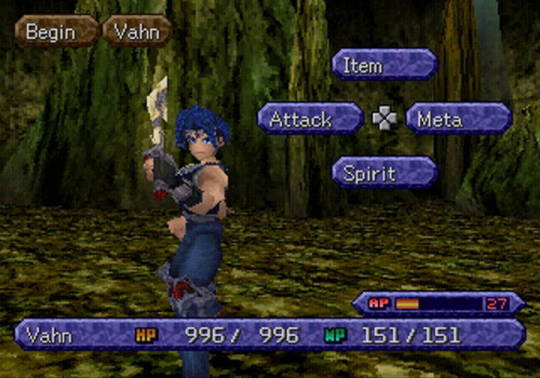
While much of the flourishing RPG genre was simply following in Final Fantasy’s footsteps, Legend of Legaia had the hipster appeal of trying to do something different. The story was standard genre fare: A martial artist from a village at the edge of the world, you set out on a quest to beat back the Mist that has consumed the surface and spawned countless monsters, pushing humanity to the brink.
Legaia stood out for its combat system, which was turn-based but also heavily derived from fighting games. Rather than having a generic “fight” option in battles, players targeted different strikes as left, right, high, or low, chaining them together into increasingly elaborate combos as the game proceeded. It added a tactical richness to combat that few of its peers could match, and is a franchise worth re-examining.
Parasite Eve

Adapted from a popular, contemporary Japanese novel of the same name, Parasite Eve was a bit of a genre hybrid from developer Square. Equal parts action RPG and survival horror, it follows a New York City cop trying to stop an entity named Eve from destroying humanity through spontaneous combustion.
Like Square’s Vandal Hearts, it featured pausable real-time battles and the ability to target particular body parts, with abilities tied to the “Active Time Bar” (ATB) system pioneered in the studio’s Final Fantasy games. Critics praised its interesting and immersive design at the time, although its legacy was somewhat overshadowed by the more “pure” RPGs and survival horror games of the time, respectively. In retrospect, however, its infusion of RPG progression systems into a survival horror framework can be seen reflected in more modern games such as The Evil Within, although its pausable real-time combat has been less explored subsequently.
Shooters
Medal of Honor

Several years before the original Call of Duty kicked off the oversaturation of WW2 first-person shooters in earnest, Medal of Honor set the bar. Steven Spielberg developed the story, working with the same historical military consultants he collaborated with on Saving Private Ryan.
Where previous shooters had been relatively light-hearted affairs about blasting hordes of demons, Medal of Honor was one of the first serious, cinematic shooters that presaged future classics like Spec Ops: The Line by exploring the medium’s serious narrative potential. Critics and fans also praised its gameplay, however, as one of the most generally refined shooters released to date.
Sports
Tony Hawk Pro Skater 2

The original Tony Hawk Pro Skater was an enormous success when it launched in 1999, but it was the follow-up from the next year that truly cemented it as one of the most beloved sports franchises of all time. The action centered around arcade-style gameplay, with the player flipping and grinding over open levels to rack up as many points as possible from tricks and combos within two minutes.
Collectibles and level-specific objectives keep it spicy, and the addition of level- and skater-creation tools gave it a ton of replayability. The series continued through the ill-received Tony Hawk Pro Skater 5 in 2015, but for many, the second remains the definitive entry and still one of the most highly rated sports games of all time.
Madden NFL 98
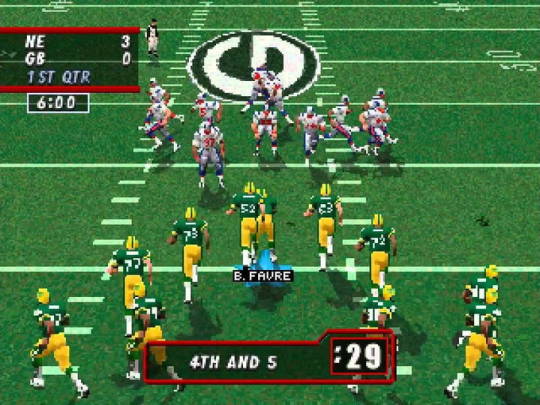
1997 saw the Madden football franchise’s first stab at 3D with Madden Football 64, but for our money, the best sports game of the year was the less ambitious and far more refined Madden NFL 98. While other franchises made the leap to polygons, development efforts at Madden instead were focused between 97 and 98 on punching up the game’s artificial intelligence, which made this the most strategically sophisticated football game ever released at the time. As is often the case from this era of consoles, Madden NFL 98’s late 2D sprite graphics hold up better than the early efforts at 3D that followed it.
Strategy
Final Fantasy Tactics
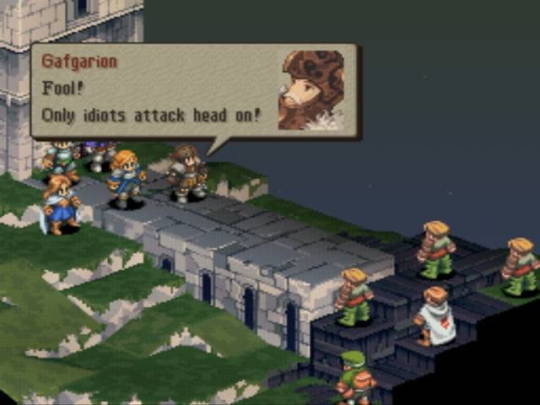
FFT wasn’t the first tactical RPG to come out of Japan — the Shining Force and Ogre Battle series already broke that ground for western console audiences. It’s far and away the most beloved and influential one, however.
The series’ traditional linear battles of three to four party members lined up facing a few enemies. In turn, Final Fantasy Tactics opened up into a much richer, isometric, grid-based combat reminiscent of X-COM, with an elaborate job system allowing for deep, strategic party customization.
Set in the world of Ivalice (which was featured in later entries like FF12), it tells a mature tale of competing noble families, warring nations, and the intersection of church and state. Spin-off sequels for the Game Boy Advance were solid, but none ever quite captured the magic of the original.
Survival horror
Resident Evil 2

While the first Resident Evil is beloved for creating “Survival Horror,” Resident Evil 2 perfected the formula. It picks up two months after the events of the original, as the Umbrella Corporation’s zombie plague spreads from the company’s labs to nearby Raccoon City. Like the first game, it features two protagonists, puzzles, exploration, and limited resources for ammo and saving the game, forcing careful and strategic play.
It added the “Zapping System,” in which players could revisit scenarios multiple times as different characters, with unique challenges designed for each of them. Its presentation was also praised as improving upon the first game in virtually every way. Though the series has continued for decades — we’re up to Resident Evil 7 as of 2017 — many still consider the second the high watermark. Resident Evil 2 also received a stellar remake in 2019.
Silent Hill

The PlayStation’s 3D capabilities opened up a whole field of possibility for cinematic horror, which is why the survival horror genre was born on it. Where the early Resident Evil games relied more on jump scares and zombie movie tropes, Silent Hill took a decidedly more psychological and surreal approach.
You play as Harry Mason, searching for his daughter who goes missing in the creepy town of Silent Hill while passing through on vacation. The whole town was blanketed in a thick fog, cleverly utilized to cover for the system’s draw distance limitations, which gave the game a memorably menacing atmosphere, particularly when played alone and late at night.
Drawing from an interesting range of influences like Lewis Carroll and David Lynch, Silent Hill is seminal in establishing the subtler and more artistically interesting strain of psychological horror in video games.
Resident Evil
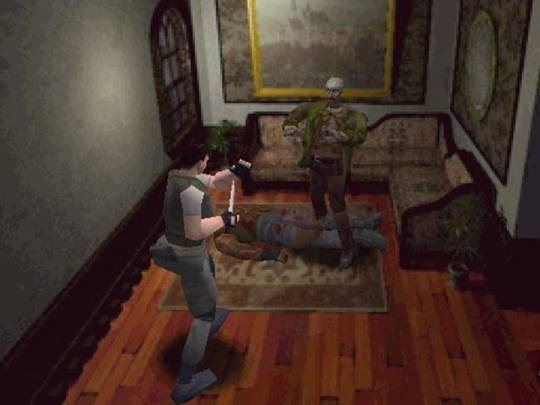
Released first in Japan as Biohazard, Resident Evil is Shinji Mikami’s genre-defining survival horror opus. Although not the first horror game, it exerted such a gravitational pull that, like shooters in the wake of Doom, any other entries in the genre were called an imitation for a while — and it’s still basically impossible to talk about survival horror without Resident Evil featuring prominently in the discussion.
You play as Chris Redfield and Jill Valentine, special forces units sent to investigate their missing teammates in a zombie-infested mansion on the outskirts of Raccoon City. It established the now-standard genre gameplay of careful exploration, puzzle solving, and resource management. Players remember it most fondly for its creepy atmosphere and unsettling presentation, however, making clever and efficient use of the hardware with 3D characters on pre-rendered backgrounds to achieve unprecedented immersion.
Dino Crisis

If you liked the survival horror stylings of Resident Evil auteur Shinji Mikami, but weren’t into zombies, Capcom still had you covered. Much of the same team including Mikami himself also developed Dino Crisis, a survival horror game set on a secret island research facility wherein genetically-revived dinosaurs run rampant, Jurassic Park-style. Capcom contrasted it with Resident Evil by marketing it as “Panic Horror” rather than survival, because of the emphasis on dinosaurs as a quicker and more aggressive/intelligent threat than zombies.
Unlike the pre-rendered backgrounds of its predecessors, Dino Crisis featured real-time 3D environments, adding to the sense of immersion. Although not quite as viscerally scary or enduring a franchise as Resident Evil, many felt that it improved upon those games in nearly every way, offering a tense, fun, and more consistently paced experience.
The best Xbox 360 games
The best NES games of all time
Collected ’em all? Here are 10 collection-based RPGs Pokémon fans should try
0 notes
Text
Nintendo Switch - Impressions

So Nintendo’s new console is out and causing quite the stir for both negative and positive reasons. After owning the console for around a month, I can safely say that I am really enjoying it as a gaming console and as a portable device. I have spent the majority of my time playing Zelda: Breath of the Wild (lets be honest who hasn’t?) and the console has really delivered on a lot of what Nintendo promised. There is a lot of great things going for the Switch and it has been fantastic hearing the positive reception from my friends and to see that it is selling just as well as they’d hoped if not better.
What Is Working Well

The portability of the switch is absolutely incredible and still boggles the mind that I can take games on the go like Zelda and in the future something like Skyrim (cross your fingers everyone). The device’s battery life leaves a bit to be desired, but at 3 hours and around 10 with a portable charger, it is the perfect for train trips and commutes of a short distance. The primary portability use that I have so far is playing my games in bed or when the TV is in use, or I can’t be bothered being in my games room. It gives you more options to keep playing.
I adore the feel of the system and the overall design when in portable mode. The console feels very sturdy and unlike the DS doesn’t feel like I could break it just by holding it. It is comfortable to hold and feels ergonomic unlike other handhelds in the past. I really enjoy the way the thumb sticks are responsive and feel natural unlike the vita and 3DS thumbsticks. The out of the box piece of plastic controller also feels much better and is easy to hold. The original look, made it seem like it was going to be hard to hold, but when both Joy-Cons are strapped into the plastic hold, it feels natural and familiar. Nintendo have finally figured out how to make a controller that makes sense while maintaining their quirky nature
Just like the original commercial, switching the Switch is just that easy. Pulling the switch out to take your games on the go feels futuristic and certainly is something I don’t foresee getting old. Even better is when you put your handheld mode into the simple, yet effective dock to output it to your tv. This concept was definitely something I needed to see to believe and they have pulled it off effectively.
The tablet of the Switch is fantastic to look at. Another doubt that has been put to rest is how are games going to go with a 720 output when so many games are concerned with the highest possible output these days. The tablet of the Switch looks great. The colours are vibrant, the touch is responsive and it is perfect to look at from every angle. It also seems like the perfect size between not being big enough and being too big.
The UI of the Switch is very stylish and easy to use. Nintendo have clearly looked at the competition to see what is working well and how to improve the quality of their Storefront. The E-Shop (lacking music) is quick, responsive and easy to navigate. The way the UI functions as a responsive and organised system gives the feel that the Switch means serious business and should be considered equal to the Xbox One and PS4.
Zelda: Breath of The Wild. What can I say. This game is remarkable and clearly one of the best games ever made. The way everything works together so well, the world reacts to the systems surrounding it and the fantastic gameplay loop that requires patience in combat, planning when cooking and preparing for battles and also one of the most open, engaging worlds ever shown in a video game. This makes the Switch purchase justifiable and 15 hours in I have only just scratched the surface of this incredible experience.
Even Better If
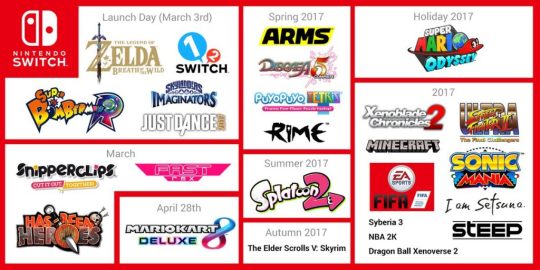
Obviously one noticeable absence for the Switch is games. Games right now and also games coming in the future right now there are no big titles announced for the Switch coming in the latter stages of the year and nothing in the immediate horizon other than the re-release of Mario Kart. This is a huge problem as the Xbox One and PS4 are completely spoiled for choice right now with huge games coming and consistently releasing all through the year. Games like Mass Effect, Shadow Of War, Prey etc. are expectedly absent from Nintendo’s console and they need something to release in order to keep their loyal fans happy during the holiday season. The recent indie movement and announcement of a bunch of high quality experiences coming to the platform has certainly done a lot to instil confidence and it would amazing to continue this trend if Nintendo cannot get the biggest AAA releases on its platform.
The online community is a massive aspect of gaming consoles these days and currently the Switch has no online community. Coming very soon (so they say) is the Switch’s answer to Xbox Live and The Playstation Network. Nintendo need to release this flawlessly and ensure the experience is user friendly and free of bugs. Releasing this after the console release may benefit them greatly, as they now have a chance to respond to the feedback and criticism. One game a month to rent is definitely not something people are going to be throwing money towards. Currently Nintendo have returned to friend codes. In the globalised world of gaming, I have friends from all over the place from Facebook groups and forums that I want to have on my friend list. Acquiring their friend code is a pain and remembering mine or checking online is a unnecessary hassle. With this you are also unsure who is adding you as names for users can repeat so you can have anything you like. Blake is adding me. I know a Blake, but is this the Blake that I know? This situation should not be occurring in 2017 for an online console. Also it is very, very, very important Nintendo get their shit together and sort out home systems and cloud saves similar to Xbox and Playstation. Right now I cannot take my saves to another console. This downright idiocy and completely frustrating in terms of a user experience. Buying a Switch to have at my parents etc. or simply wanting to log in to a friends and play my games is currently impossible unless I want to start again. Who knows what happens if my Switch breaks and my 100 hour Zelda video game save is lost. These are all very important aspects of the service that need to be fixed or added as soon as possible
As there is with any launch of new hardware, there are currently a ton of technical problems that people are having. Touch wood, I haven’t had anything go wrong with my Switch, however it is definitely widespread news that the left Joy-Con is an issue amongst the community. People have noticed that in a variety of situations the left Joy-Con will lose connection to the Switch and as a result it is causing huge latency issues that have dramatic impacts on gameplay or little dips of control. Watching Link pelt to the ground after walking off a cliff for no reason was definitely an annoyance the first and only time it has happened to me, but this is not acceptable. Hopefully Nintendo can either organise a software update that addresses the problem or they may face re-calling the left joy-cons and replacing them altogether. Another huge issue that has caused the sale of many screen protectors is the fact that sliding the Switch into the dock has caused noticeable scratches to the screen. This would cause me to hurl my Switch into the sun, as the very mechanic that sells the devices has been harming the product. People have been adding soft surfaces to the inside of the dock, adding tempered glass or screen protectors or withholding from the dock altogether as a result. It will be fascinating to see whether Nintendo remake the doc or add something that will keep the surface of the tablet safe. The battery life has also been an issue for people, as Zelda is lasting anywhere between 2 and 3 hours depending on brightness and sound. As a portable this is an issue. After taking my Switch down to Geelong for trips and now a bus trip too and from Canberra for 8-9 hours, I am glad that I spent 100 dollars on a portable charger. The device sucks power up and isn’t really designed to be a take out all day and keep playing kind of device. The Vita and 3ds’ charge make the Switch look terrible in comparison. With the output of the games, I really can’t complain.
One kick stand - really? That is pretty much all that can be said about that. What were they thinking. It is terrible quality too. I fear for my Switch’s life whenever I pull it out. I would not be surprised to see the Switch 2.0 release with 2 kickstands to make it that much sturdier.
So many additional purchases and ludicrously high prices. As mentioned previously the need for a screen protector and portable charger are only some of the extra purchases that I have made for the Switch. A carrier case, microfibre and a pro-controller are all additions that I have made so far with new Joy-Cons a likely buy down the track when hopefully a new Mario Party game is announced . This has added to price dramatically and the need to have these things begs the question, should they have come in the box? Nintendo definitely enjoy profiting from peripherals, however these prices and needs seem slightly ridiculous.
Hopes For The Future -
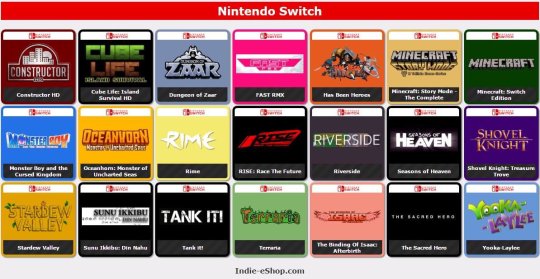
The Vita was definitely an impressive machine when it launched. It had ridiculously good games both of the Indie and AAA caliber. However it never fully became the AAA machine that many wished it was. The promise that the handheld had originally due to the hope of a new God of War, Portable Infamous and the like came to a grinding halt when Sony didn’t support their machine with exclusive games and massive releases. The Switch will definitely have the AAA support that Sony never gave their handheld and with the notion that this is actually a home console, there is a guarantee that AAA Nintendo games that will be playable on the go in the future. This is terribly exciting if third party publishers can start releasing their games as well in order to develop the best portable gaming ecosystem in history.
Speaking of AAA support, this is the biggest aspect that will either make or break the Switch. The Wii-U suffered with the lack of third party support and games like Watch Dogs, Call of Duty and Assassins Creed didn’t really capture gamer’s interest on the platform due to inferior versions and delayed release dates. It was great playing Assassins Creed 3 months after it had already come out (not). If the Switch is too succeed then it must get developers on board and releasing their games in a timely manner. With the limited power compared to the PS4 and Xbox One and soon to be dwarfed by Scorpio, this is definitely Nintendo’s biggest problem. Without these games, we will again rely on Nintendo’s first party and indie releases for the Switch. Even if Nintendo organise to get older games and ports like they have with Skyrim, the system will have more chance to succeed. people get on board
The boldest move that Nintendo could possible make is to leave the 3DS behind and move Pokemon to the Switch. After Sun and Moon’s absolutely massive release, selling hundreds of thousands of copies, Nintendo needs to ensure that Pokemon is only available on this platform. I am sure that this will enrage many people, but it wouldn’t be the first time that people have had to move on from a system. A Pokemon game with more processing power and a better quality screen and also the ability to play it at home on your TV would be absolutely incredible and a huge system seller for the console. Nintendo need to strike while the iron is hot after the hype generated by Pokemon Go and this may be the necessary unit mover that the Switch needs.
Open world RPG’s are exactly what the Switch needs. After seeing how people have lost themselves in the world of Hyrule with Zelda, the Switch and Nintendo need to embrace this style and genre and get as many games as possible that are similar. People are enjoying having something as deep, complex and engaging that can be taken on the go. More of these games will be a great thing for the console.
An obvious need and hope is the fact that Nintendo absolutely bring it with their AAA exclusives just as they did with the Wii-U. Zelda has set the bar at absolutely unreachable heights, however I have faith Nintendo understands how essential it is to release games that are this calibre. If the Switch picks up a larger audience, then these games have the chance to really shine as some of the best ever released just as Zelda has. A new Metroid game, a new Mario, A new Mario Party and a new Smash Brothers and a exclusive Pokemon Switch game are all at the top of my list.
#Nintendo switch#Nintendo#Switch#zelda breath of the wild#zelda#games#gaming console#impressions#mario
1 note
·
View note